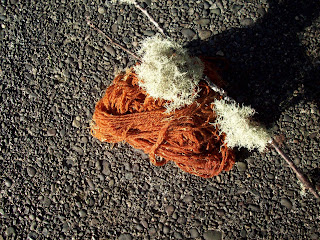Usnea is a pale gray-green frutcose lichen which looks like a mini-shrub. It grows prolific on the branches of deciduous trees in the coastal areas of the Pacific Northwest. Because Lichen will not grow in a polluted environment, the presence of lichen is an indication of high quality, clean air.
Recently, my neighbors pruned their fruit trees and the fallen branches were filled with Usnea. I gathered enough to fill my dye pot, covered with water and left it to simmer for 3-4 hours. Then I entered a skein of wet, wool yarn into the dye bath and let it simmer right along with the lichen. The bits of lichen that mingle with the yarn will shake right out later. Lichen are rich in tannin, a natural mordant, so no other mordants are needed to ensure a stable color. Depending on the genus, Usnea has been known to yield orange, yellow, green, and even blue or purple dyes on textiles. After a couple of hours of simmering, my yarn emerged a lovely, rusty shade of orange.
One of the things I love about dyeing with lichen is that they leave a delicate, woodsy odor in the fiber. The early Harris tweeds of Scotland were known for the distinct lichen odors of the wool fibers woven into the fabric.



Hi! Thanks for posting this. I was looking everywhere for information on liken dyeing. Have you ever managed to get purples from this one? arton5plus@gmail.com
ReplyDelete